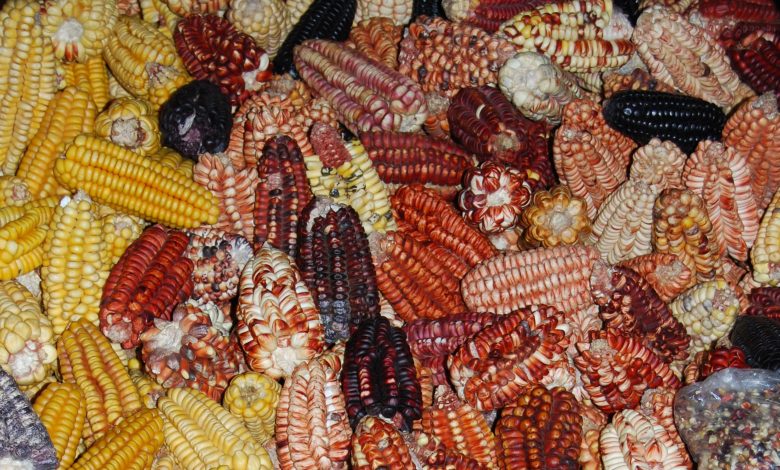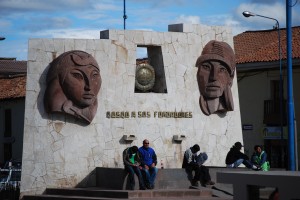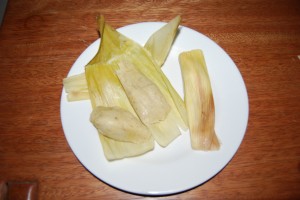Women Warriors, Corn, and Humintas

Like potatoes, corn may be a crop which plagues modern people with an excess of sugars in its contemporary omnipresence. But in early times, both potatoes and corn were miracles.
The Incas celebrated these miracles, especially at harvest time, in the figure of a woman. Not just any woman, she was a warrior who defeated the pre-Inca inhabitants of Cuzco and claimed space for her people and their crop par excellence, corn.
Mama Huaco, as she was called, was not only a warrior she was a kind of Eve. Part of the original set of brothers and sisters to come out of the cave at Tambo Tocto in Pacarictambo, the Inca place of origin, she was both contrasted and paired as a kind of alter ego with Mama Ocllo, the rather distant sister wife of the Adam, Manco Capac.
At least that is how it is in Sarmiento’s telling of the story. In another version, when they came out of the land in the earlier creation on the Island of Titicaca in the lake of the same name, she is the wife of Manco Capac. Garcilaso, the great Spanish-Inca writer, simply joins the women as one, Mama Ocllohuaco.
People in the area of the Island talk about how you can see carved in the rock where she stopped to pee because of how the force of her urine opened a channel. Her passage through the landscape is literally engraved in stone, although people there just call her Mama Ocllo.

The anthropologist Olinda Celestino described this important personage.
Between April and July feasts of recognition and gratitude were carried out. Many of them were associated with Mama Huaco who had given them the first corn. Even today, Mama Huaco is the goddess of the corn harvest in Cuzco. She is also the protector of potatoes around Lake Titicaca and in other regions of the Andes.
The chronicle by Cristobal de Molina, often called The Cuzqueño, talks about the worship of Mama Huaco, especially in relationship to a field called Sausero (129002).
The month of April [the Incas] called Ayrihua; during it they would harvest their fields and bring [their crop] together and enclose it, which they called aymoray. The noble young men who had been knighted, would leave the field called Sahuasera [Sausero] to bring in the corn that had been harvested in it. The field was below an arch where they say Mama Huaco, the sister of Manco Capac, was the first person to sow the first corn. The field was cultivated every year to support the worship of the body of Mama Huaco by making chicha which was necessary for the service of that body. They would bring the corn and hand it over to the persons who cared for that body which was mummified. Then, in order, they would gather the corn from the fields of the Maker [Viracocha], the Sun, the Moon, and Lightning, the Inca and Huanacauri, and of all the dead lords. They would bring it in small bags while singing a song called aravi, dressed in fine clothes. Then all the people of Cuzco would go harvest that corn. Only on the first day was it brought by the young knights. The priests they called tarpuntaes would burn a llama in sacrifice, begging the Maker he give good years. The ceremony would last four days after which everyone returned to their homes.
While it is tempting to fit everything the various chroniclers have told us into a single story line, the stories do not always agree. As Brian Bauer pointed out, Bernabe Cobo disagreed with Molina, and said that the field called Sausero was dedicated to the sun.
Already fragmented by the ways the stories were collected piecemeal by occasional writers, the myth of Mama Huaco may face another splitting apart. Her priests may have kept a body of tales and stories together as part of her worship — certainly the chroniclers suggest this — but ordinary people today who keep the stories alive, just like people in the past probably, tell pieces of them in association with things that happen or places rather than in a bound set of folk tales. In this they are like so many other Native American peoples who have many origin stories and many, often contradictory, tales of sacred heros.

No matter who the field was dedicated to, Bauer has identified where Sausero probably was located. He argues it was near an arch that used to exist called Arcopunco, now the name of a street east of Limacpampa. This street continues to become Avenida de la Cultura and connects with the main highway to Puno and Lake Titicaca, what used to be called Collasuyo.
Cobo tells pretty much the same story as Molina, though he does add one important detail. As soon as the harvest of Sausero was finished:
All the lords and important people of Cuzco , accompanied by a large number of other people, went to the same [field] with their plows. They plowed the field. After they had finished, they returned with great rejoicing to the main square, wearing the tunics they had won in war.
The Incas, and their contemporary descendants, compared planting and growing food to war. So it makes sense that Mama Huaco would be considered a fierce warrior, a woman, and a goddess of agricultural production.
Cobo continues his story of this month of harvest, which he calls May, to talk about what individual families did, and not just what the nobility did.
This month certain ceremonies were made to Mamazara [Lady Corn], which was a universal guaca [sacred figure, object, or place]. Everyone had one in his home, and these guacas were made in the following way. Each person would take a certain amount of the most unusual [ears of] maize, which would be a small amount, and with certain ceremonies, he would put the maize in a storage bin called a pirua. The maize would be wrapped in the richest mantles that the person had, and there he would watch over it for three nights. After they had covered the said bin, they worshipped it and held it in high esteem, saying that it was the mother of the maize in their [fields] and by virtue of it [the Lady Corn], each year maize was produced and preserved. At this time each year, they made a special sacrifice to the bin. In this sacrifice the sorcerers would ask the said pirua if it had strength enough to last for the coming year.
From the corn, the Incas would make many dishes. But some of the most common were sankhu, as Rosario Olivas Weston spells it, and humintas. Sankhu was the ceremonial bread used in offerings to the deities and as a sacrament to share with people undergoing the ritual. Humintas were the everyday fare.
Today, people in Cuzco distinguish between humintas and tamales. The word tamale comes from Mexico, and generally is made from dried corn, while humintas maintain the Quechua word though they now are generally made with sweet corn and include additional spices, such as cinnamon and anis seed.
In what follows we add a recipe kindly given to us by Señora Mercedes Morveli Umeres, who is a fine, local, Cuzco cook. We have translated the original recipe, but have not tried it outside of Cuzco ourselves. However, the basic ideas and concepts have translated well. Doña Mercedes, of course, did not give everything. What cook does? As a result, we do not have the exact amount of baking powder or soda, but recommend trying a small amount, given the quantity of humintas, following the common sense of the cook. We also worry the amount of milk given may be too much if you use watery American sweet corn. Nevertheless, enjoy and let us know how they turn out.

Humintas of Sweet Corn
Recipe courtesy of Señora Mercedes Morveli Umeres
A delicious morcel made from sweet corn that comes from the Sacred Valley of the Incas, where a wide variety of types of corn exist to conquer the most demanding palettes, humintas are best enjoyed with a delicious cup of coffee.
Ingredients : (20 humintas)
1. Sweet Corn 2 kilos
2. Lard ¼ kilo
3. Eggs 8 eggs
4. A cup of milk
5. One tablespoon of anis seed
6. One tablespoon of ground cinnamon
7. One tablespoon of baking powder or soda
8. Sugar to taste
9. Corn husks (called pancas in Cuzco) in which to wrap the huminta.
Directions:
First you remove the grains of corn from the cobs and then grind the corn kernals with the anis in a food processor. Then you add in the lard, the eggs, and the sugar. When it is well mixed you add either the baking powder or the baking soda and the milk. Finally, you add the cinnamon. Continue mixing it until it is thoroughly mixed and light. in order to have everything ready to fill the cornhusks.
If the cornhusks are dry, soak them in water until soft. Then you add a good sized dab of dough in each corn husk and fold them tightly. Once you have all the humintas made, start a pot of water heating with a steamer (you might wish to add some left over husks to the boiling water). Place the humintas in a steaming rack and steam them for some 30 minutes before serving.
Secret:
Humintas should be made, start to finish, by only a single person. Otherwise the original flavor will change and they will not be the same.





Means cool! Some extraordinarily legitimate factors! I admire you writing this text and also the rest of the onlinesite is extraordinarily good.